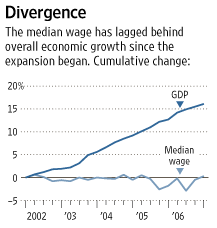Okay, here it is:
Now since 2002, the gross domestic product has risen steadly, while workers' wages have remained constant.
What does that mean? That means that as a nation, we have been producing more and more stuff. Now, some of that gets exported, but we're hardly the world's largest exporter. So where do these products end up? With the wageearners.
But how can they afford it when their wages are remaining a constant? Well, easy credit, that's how. And what eventually happens when that gets TOO easy? Just look at the headlines for the past month.
So note to future America: let's try to keep these lines more or less parallel, huh?
This chart also shows the inequities of our economic system. After all, who benefits when the GDP goes up? The pool of money from the sale of goods clearly doesn't trickle down to the typical wageearner — he remains at a relative constant. It goes to the wealthy — both individuals and corporations.
As Kevin Drum says, we shouldn't be talking about income redistribution; we should be talking about getting income distribution right in the first place. The current economic crisis has taken place in large part because the so-called "growing economy" isn't reflected in the wallets of (yes, I'll say it) the average Joe Sixpack. And when those two things get grossly out of whack, the system collapses.
A rising GDP requires a rising middle class wage in order to be sustainable. Share the wealth, or lose it. End of lesson.
P.S. And when they say that "taxing the wealthy" amounts to "class warfare", you tell them that class warfare was started at least six years ago, and the middle class has been losing.

